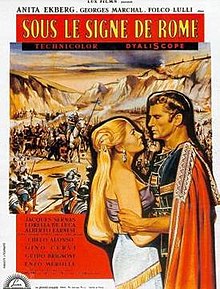Sheba and the Gladiator
| Sheba and the Gladiator | |
|---|---|
 French film poster | |
| Directed by | |
| Screenplay by |
|
| Story by |
|
| Produced by | Enzo Merolle[1] |
| Starring | |
| Cinematography |
|
| Edited by | Nino Baragli[1] |
| Music by | Angelo Francesco Lavagnino[1] |
Production companies | |
Release dates |
|
Running time | 98 minutes[1] |
| Countries |
|
Sheba and the Gladiator or Sign of the Gladiator (Italian: Nel Segno di Roma) is a 1959 historical drama film loosely pertaining to the Palmyrene Empire and its re-annexation back into the Roman Empire.
Cast
[edit]- Anita Ekberg as Zenobia
- Georges Marchal as Consul Marcus Valerius
- Folco Lulli as Zemanzius
- Chelo Alonso as Erica
- Gino Cervi as Aurelian
- Jacques Sernas as Julianus
- Lorella De Luca as Batsheba
- Alberto Farnese as Marcello
- Mimmo Palmara as Lator
Production
[edit]Sheba the Gladiator was shot in 1958.[2] Director Guido Brignone fell ill during the production on the film leading to two other directors to enter the production to help complete it: Michelangelo Antonioni and Riccardo Freda.[3] For Antonioni, he visited Brignone in the hospital and reported on what he filmed and received instructions for the next day.[3] Freda was in charge shooting the battle scenes which he did with cinematographer Mario Bava and Antonioni working with cinematographer Luciano Trasatti shooting the indoor scenes.[3] Other people credited to the film included Sergio Leone as a screenwriter.[3]
Mimmo Palmara commented that Antonioni "couldn't care less" about the film and "didn't direct the actors."[2] Freda had an argument with Palmara and unsuccessfully tried to court Chelo Alonso on set.[2]
Release
[edit]Sheba and the Gladiator was distributed in Italy on March 5, 1959.[1][2] It was released in West Germany as Im Zeichen Roms on 2 October 1959.[4]
American International Pictures acquired the American rights to the film and re-titled it Sign of the Gladiator (Sign of Rome "was a pretty dismal title" according to Samuel Z. Arkoff[5]) and cut 18 minutes from the original running time.[6] There was no gladiator in the film so they redubbed it to change the general played by Jacques Sernas into a gladiator.[5]
It was released in September 1959 in the United States.[2] American International Pictures added an end title song called "Xenobia" sung by Bill Lee which was released on AIP Records.[7] The film grossed a total of $1.25 million in rentals.[8] "We did quite well with the picture" said Samuel Z Arkoff.[5]
Kine Weekly called it a "money maker" at the British box office in 1960.[9]
See also
[edit]References
[edit]Citations
[edit]- ^ a b c d e f g h i j Curti 2017, p. 296.
- ^ a b c d e Curti 2017, p. 169.
- ^ a b c d Curti 2017, p. 168.
- ^ "Im Zeichen Roms" (in German). Filmportal.de. Retrieved January 30, 2019.
- ^ a b c Strawn, Linda May (1975). "Samuel Z. Arkoff". In McCarthy, Todd; Flynn, Charles (eds.). Kings of the Bs : working within the Hollywood system : an anthology of film history and criticism. E. P. Dutton. p. 264.
- ^ McGee, Mark (1996). Faster and Furiouser: The Revised and Fattened Fable of American International Pictures. McFarland. p. 154.
- ^ Smith, Gary A. American International Pictures: The Golden Era. Bear Manor Media. p. 117.
- ^ "Rental Potentials of 1960", Variety, 4 January 1961 p 47. Please note figures are rentals as opposed to total gross.
- ^ Billings, Josh (15 December 1960). "It's Britain 1, 2, 3 again in the 1960 box office stakes". Kine Weekly. p. 9.
Sources
[edit]- Curti, Roberto (2017). Riccardo Freda: The Life and Works of a Born Filmmaker. McFarland. ISBN 978-1476628387.
External links
[edit]
- 1959 films
- 1950s historical films
- Peplum films
- French historical drama films
- West German films
- German historical drama films
- Yugoslav historical drama films
- Films directed by Guido Brignone
- Films with screenplays by Sergio Leone
- Films set in ancient Rome
- Films set in the Roman Empire
- Films set in the 3rd century
- Films set in classical antiquity
- American International Pictures films
- Films scored by Angelo Francesco Lavagnino
- Sword and sandal films
- Cultural depictions of Aurelian
- Cultural depictions of Zenobia
- 1950s Italian films
- 1950s German films
- 1950s Italian film stubs
